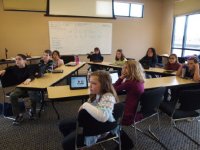Collaborative Learning Spaces: Classrooms That Connect to the World
Promote global collaborations among classrooms of the world by involving students in creating their learning space and connecting physical and virtual learning spaces.
Editor's note: This post is co-authored by Fran Siracusa, co-founder of and educational technologist for Calliope Global.
As citizens of the world, students in today's classrooms seek global contexts for learning. Opportunities for networked and international collaborations are bringing both the world to classrooms and classrooms to the world. With a focus on international standards of instruction, globally-minded programs inspire students to be curious through investigation and reflective in analysis of thought. These pathways lead to the development of cultural literacy by allowing students to examine issues of global significance through interconnected sharing of experience and exchange of ideas. Collaborative learning spaces empower students to work with each other and with students in classrooms of the world to assume multiple perspectives, explore alternative solutions, and thoughtfully solve problems.
By examining the landscape of the classroom, educators can design collaborative learning spaces that will support the teaching and learning of skills needed for the interconnected world of today and tomorrow. By seamlessly connecting pedagogy, technology, and space, teachers can create spaces that promote social learning and maximum engagement. These collaborative classrooms are alive with action -- teaching, learning, innovating, creating, making, and exploring. Innovative learning spaces can encourage both individual and collective voices, and, through use of emerging technologies, they inspire students to become skillful curators of their digital worlds. Though there cannot be a single universal blueprint for designing a collaborative learning space, teachers can use the goal of global collaboration to inspire classroom design that allows for connected sharing and learning.
While there are many design ideas that could help drive this transformation, we suggest the following three as a starting point.
1. Involve Students in the Process From the Beginning
The design of a collaborative learning space begins with a dialogue between all stakeholders. Everyone, including teachers and students, are part of the conversation and the design experience from the start. With a focus on purpose, together they can create plans for a classroom that will invite active participation and inquiry. This establishes a framework that evolves the role of the classroom teacher from distant lecturer to engaged facilitator of learning. As partners in the design process, the teacher and the students can together take a holistic approach to define the goals of a collaborative learning space by answering the question: "How will learning look in our classroom?" Curricular content can be integrated into the design process, and digital tools can allow for creativity and critical thinking. The Bubbli app allows users to create 360-degree spherical photos called bubbles. Students can capture entire scenes of classrooms, including floors, ceilings, walls, and everything in between, and then they can add audio. Social tools allow for bubbles to be directly shared with the world and organized into albums. Albums can turn groups of bubbles into interactive stories and can serve as digital artifacts to add to digital portfolios of student learning.
2. Make Every Space a Space for Learning
In the process of designing a collaborative learning space, all available areas should be considered spaces for learning. Hallways can become meeting spaces for small groups, glass and windows can be transformed into writing spaces, and classroom walls can allow groups to visually map out thinking. By removing the conventional teacher desk, teachers and students will better understand their evolving roles as co-constructors of knowledge. Without a front of the room, every seat is the best seat in the class, and students are always at the center of learning. Flexible seating allows for spaces to transform depending on the purpose of the lesson. Varied seating options, too, such as stools, rocking chairs, beanbag chairs, and floor seating, give students choice and variability throughout the day.
3. Connect Physical and Virtual Learning Spaces
The design of a learning space can act as a catalyst to promote collaboration and innovation. Seamless integration of technology into classroom furniture and lessons can empower students to create personalized paths to learning. You can design a collaboration station by moving a flat-edged table to a wall. Chairs surrounding the table will invite student groups to work and collaborate here. An Apple TV added to a mounted flat-screen television lets you mirror devices during project sessions. Physical spaces can then be connected to virtual spaces through creativity and productivity apps. Classrooms can create international learning teams with students of the world, and then use apps -- such as Nearpod, Padlet, Kahoot!, Google Drive, and Periscope -- in global collaborations and projects. Videoconferencing platforms like Google Hangouts and Skype in the Classroom allow students to connect to the world through conversations and sharing their stories.
Collaborative learning spaces have the power to transform learning and teaching. The landscape of a connected classroom unites pedagogy, space, and standards of instruction. By connecting to global classrooms in meaningful and authentic ways, there can be endless opportunities for collaboration and engagement, and, in effect, the world becomes the learning space of the classroom.
